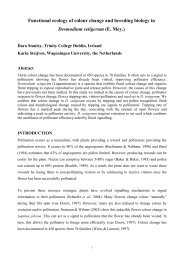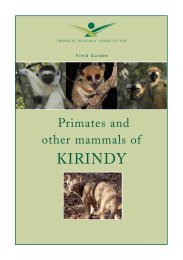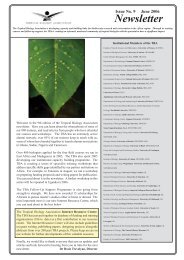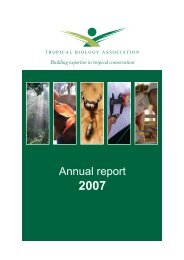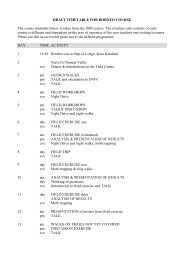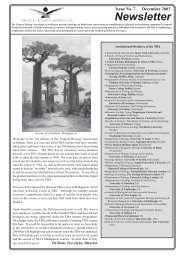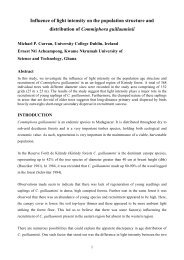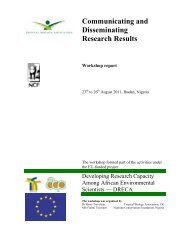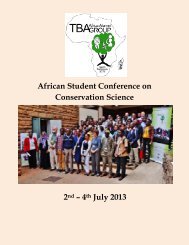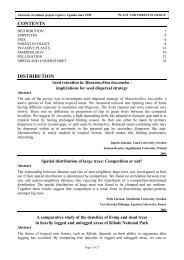Download TAAG Book of Abstracts - Tropical Biology Association
Download TAAG Book of Abstracts - Tropical Biology Association
Download TAAG Book of Abstracts - Tropical Biology Association
You also want an ePaper? Increase the reach of your titles
YUMPU automatically turns print PDFs into web optimized ePapers that Google loves.
Community Participation in Biodiversity Conservation<br />
and Management: Case Study <strong>of</strong> Osse River Park, Ondo<br />
State, Nigeria<br />
*Oladeji, S.O and Fatukasi D.T<br />
Department <strong>of</strong> Ecotourism and Wildlife Management,<br />
Federal University <strong>of</strong> Technology, Akure<br />
*E-mail for correspondence: oladejisunny@yahoo.com<br />
Abstract<br />
Local community involvement and participation are<br />
considered essential in achieving sustainable<br />
management, protection and conservation <strong>of</strong><br />
biodiversity. The level <strong>of</strong> participation <strong>of</strong> host<br />
communities <strong>of</strong> Osse River Park was assessed through<br />
administration <strong>of</strong> four hundred structured<br />
questionnaires to four out <strong>of</strong> the eight adjoining<br />
communities to the park. Staffs <strong>of</strong> the two relevant<br />
government agencies in Ondo State and Nigeria<br />
Conservation Foundation (NCF) employees working<br />
within the Park were also interviewed. The research<br />
findings revealed that though the communities were<br />
involved at the inception <strong>of</strong> the Park, however their<br />
level <strong>of</strong> engagement is low (25%) in spite <strong>of</strong> the<br />
government and NCF’s investing in environmental<br />
education, community sensitization, park protection and<br />
surveillance. According to 50-70% <strong>of</strong> the respondent,<br />
government and NCF’s invested more in park protection<br />
and surveillance. Only 30% and 10% <strong>of</strong> the respondents<br />
identified provision <strong>of</strong> inputs and intensification <strong>of</strong><br />
conservation education as needing attention,<br />
respectively. The research identified the need for<br />
increased financing from the present 5-25% <strong>of</strong> the<br />
government’s commitment in finance (and research)<br />
and NCF’s input in fund raising. Such investment could<br />
be reduced if the identified need for improved<br />
stakeholders’ relations, engagement, intensive<br />
conservation education and integration was met. The<br />
research output will greatly help in the proper<br />
integration <strong>of</strong> all the stakeholders in an effort to achieve<br />
sustainable biodiversity conservation <strong>of</strong> Osse River Park.<br />
It is recommended that NCF’s increased focus on<br />
research in biodiversity and development <strong>of</strong> ecotourism<br />
in the integration process.<br />
Keywords: Stakeholders, biodiversity conservation, host<br />
communities, Non-Governmental Organisation<br />
Impacts <strong>of</strong> Pastoral Communities on Forest Diversities<br />
in Mathews Range Forest Reserve, Kenya<br />
Peter Fundi Njagi<br />
Department <strong>of</strong> Ecology and Conservation, Institute <strong>of</strong><br />
Primate Research, National Museums <strong>of</strong> Kenya<br />
Emails for correspondence: fundi@primateresearch.org;<br />
fundinjagi2000@yahoo.com<br />
Abstract<br />
The pastoral community’s livelihood has over the years<br />
depended on livestock keeping with major concerns<br />
about the long term sustainability <strong>of</strong> communally grazed<br />
rangelands. Prolonged droughts are forcing Samburu<br />
pastoralists to search for pasture and water within their<br />
only water catchment forests. To understand the impact<br />
this response has on forest structure, we characterized<br />
the habitat and determined the threats facing high<br />
altitude forests <strong>of</strong> Mathews Range Forest Reserve.<br />
Quantitative approach <strong>of</strong> vegetation sampling using<br />
20m by 20m quadrats was used to characterize the<br />
habitat in assessing the status and extent <strong>of</strong><br />
anthropogenic threats. The habitat was found to<br />
comprise <strong>of</strong> 67 different tree species, 16 shrub species<br />
and 28 species <strong>of</strong> herbs and grasses. High canopy trees<br />
had the highest Shannon Weiner diversity index<br />
(H=3.31) compared to shrub or middle storey layer<br />
(H=1.70) and the herbaceous layer (H=2.82). Felling<br />
trees for livestock forage accounted for 50.5% <strong>of</strong> the<br />
observed habitat destruction with elephant destruction<br />
contributing to 25.8%. Threats attributed to human use<br />
<strong>of</strong> plant resources, honey harvesting and fire in the<br />
habitat were minimal. In total, 32 tree species were<br />
found to be affected by either anthropogenic or other<br />
related causes. The study revealed that pastoralists’<br />
traditional cultural practices which promoted<br />
conservation are being overshadowed by the need to<br />
cater for community’s livelihood at the face <strong>of</strong> changing<br />
climate. Conservation policies geared towards<br />
conservation and management <strong>of</strong> pastoral landscapes<br />
should therefore be developed and enforced.<br />
Keywords: Livelihood, climate change, habitat, Threats,<br />
Mathews Rage Forest Reserve




